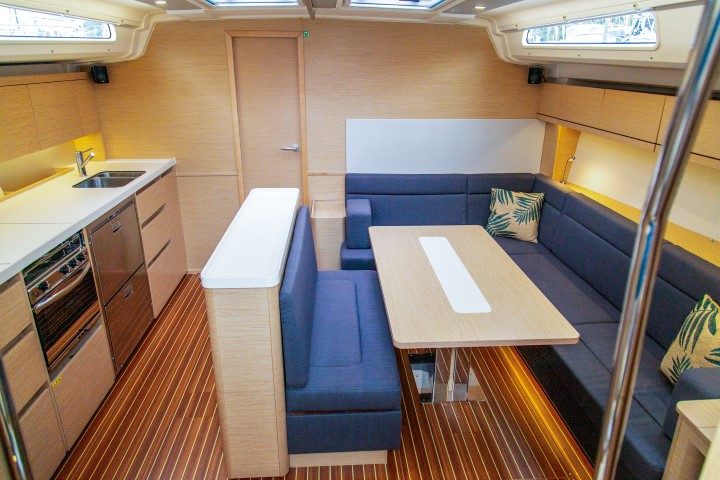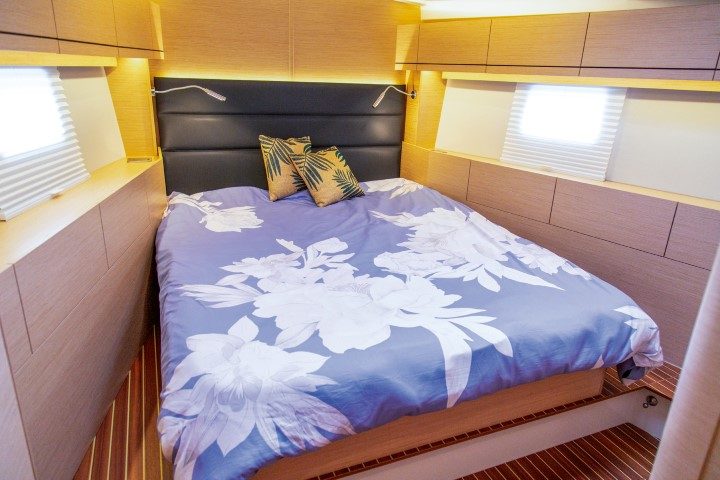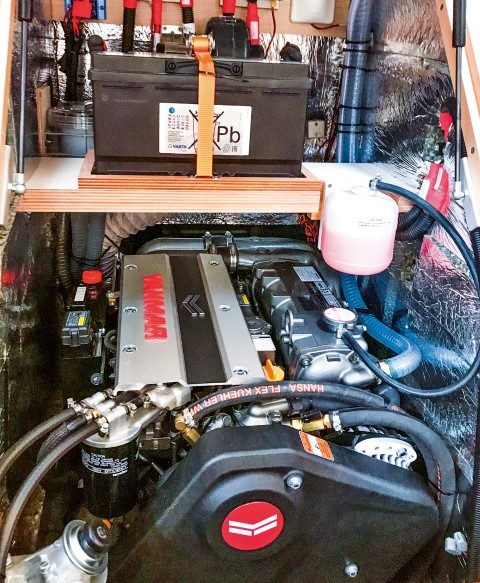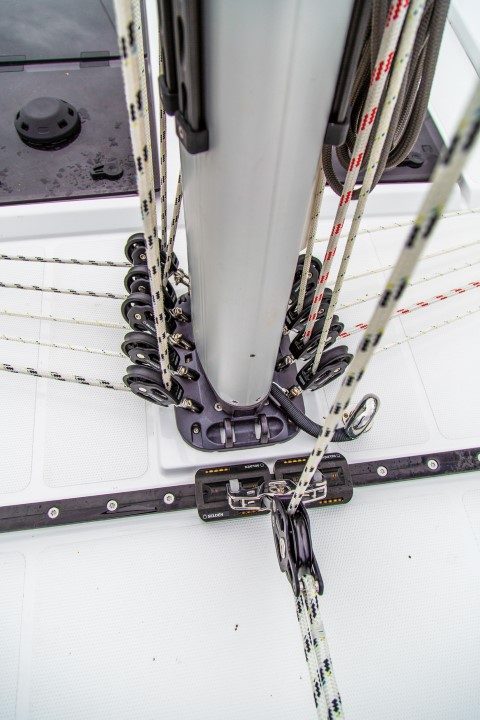‘Behemoth’ is a word which springs to mind or, perhaps more nautically, ‘leviathan’.
- Self-tacking jib and in-mast furling
- Spacious cockpit for racing or entertaining
- Easy sail handling
- Light helm
- Quality finishes and stylish interior

It wasn’t that long ago a 15m cruising yacht was considered big enough to require full-time crew. How times have changed. Today many consider 15m yachts perfect for a couple.
Unquestionably some of that’s due to attitudinal expectations, bigger being considered better. What’s really made bigger yachts even possible are the technological advances in sail handling systems. The Hanse 508 typifies these changes.
Dockside
Like all boats in the Hanse range, the 508’s been designed by Judel/Vrolijk, with hull and decks being GRP balsa sandwich, laid with vinylester resin and an isophthalic gelcoat. Bucking the current trend towards chines and twin rudders, the Hanse’s hull is round bilge with a deep single rudder. The keel is cast iron and there are two depth options, drawing 1.98m and 2.4m respectively. Ours had the deeper keel – some 400kg lighter than the shallower version.

The 508’s available in four different layouts, though the saloon, galley area and twin aft cabins remain the same for all. As mentioned, one option has a crew berth in the front storage area, but for me it is ideal storage for bulky items such as sails, fenders, spare anchors and outboards.
Further aft, the front cabin can be optioned as either twin double cabins or a single, expansive owner’s cabin. There are optional layouts aft in terms of the number and layout of heads/showers, a navigation station and an additional crew cabin for charter use.
Our boat had a very practical layout – the single owner’s cabin with adjacent ensuite forward, a navigation station, twin aft cabins each with a head and one of these having an adjacent shower. The combination head/shower is accessible either from the sleeping cabin or via a separate door adjacent to the companionway.

On the water
The 508’s standard engine is a turbocharged Yanmar 4JH4T developing 75hp at 3,200rpm, driving a two-bladed propeller through a Saildrive leg. The start battery is located directly above the engine, keeping the wires to the starter motor short.
The installation looks slick and the wiring’s beautifully done. The front of the engine – dip stick, water expansion tank, salt water pump and alternator belts – is accessible via the lifting, counter-weighted companionway, while side access is from hinged panels in the twin aft passageways.
 This boat has the optional bow thruster, making marina manoeuvring a walk in the park. Out in open water the yacht slid along comfortably at seven knots at cruising revs, with just shy of nine knots available if you crack the whip.
This boat has the optional bow thruster, making marina manoeuvring a walk in the park. Out in open water the yacht slid along comfortably at seven knots at cruising revs, with just shy of nine knots available if you crack the whip.
I’m on the helm when the call’s made to head to wind to unfurl the sails. I crank the wheel a bit over a turn and the yacht spins around like a big dinghy within a boat length. An amazing response. I do a lot of helming over the next two hours in conditions raging from virtually nothing to 25 knots and the response continues to impress.
Even close reaching in 25 knots of breeze with an over-trimmed main couldn’t induce a round up, nor did the helm load up significantly. It seems designers Judel/Vrolijk have learned a trick or two from their top-level racing designs.
Hanse offers four grades of sailcloth, each a step upwards offering better performance at a higher price. The sail cloth on this boat is the FCL (Fast Cruising Laminate) fabric, one step up from your basic Dacron.
The standard 95% self-tacking jib has four leech battens set parallel to its luff. One common criticism of self-tackers is their lack of area in light conditions, but the Hanse wasn’t slow in the light. It’s aided by the biggish main, which combined with correct mast placement balances the self-tacker, giving enough total area for light winds. During the hour spent sailing around in two- to five-knot winds I was always able to manoeuvre and tack the yacht.
For me, the benefits of the self-tacker, especially in this size of yacht, hugely outweigh any perceived downside. Tacking is as simple as turning the wheel, while the headsail flicks effortlessly across onto the new tack.
Our Hanse has the optional Seldon in-mast mainsail furling. No question, past in-mast furlers have earned a less than glowing reputation for sail shape – a hollow leech being one issue – along with horror stories of jamming under pressure. But in-mast furling systems have come a long way.

The Hanse mainsail has five full-height vertical battens to support a positive leech and the obviously well-sorted Seldon engineering made the unfurling/furling process as simple as that of a furling headsail.
Of course, the laws of physics still apply – the mainsail is a sizeable 65.5m3 in area – and careful co-ordination between the person easing the outhaul and the one operating the furling unit is essential. Given that and proper maintenance, an in-mast furling should be no more or less prone to issues than a furling headsail.
 The primary winches are twin Lewmar 55 self-tailers, with our boat having the electric power option. This made all sailing operations – halyard hoisting, sheeting, vang, outhaul, furling etc – as easy as fitting the appropriate rope into the self-tailing winch and pushing a button. Tension to suit, apply the jammer, free up the winch and job over. Too easy.
The primary winches are twin Lewmar 55 self-tailers, with our boat having the electric power option. This made all sailing operations – halyard hoisting, sheeting, vang, outhaul, furling etc – as easy as fitting the appropriate rope into the self-tailing winch and pushing a button. Tension to suit, apply the jammer, free up the winch and job over. Too easy.
I found the standard layout got a trifle cluttered if the trimmer and helmsperson were on the same side, but as the German sheeted main can be operated from either side this isn’t a major.
Both main and headsail have halyard locks at chest level on the mast, which locked off at the start of the season take the loads off the jammers. As always, correct halyard tension is essential for good furling – too tight isn’t good for sails or bearings, too loose and the sail doesn’t furl properly.
Our review day had been scheduled as part of a Hanse owner’s regatta organised by the local sales agent Dominic Lowe and the local Hanse agent, Windcraft. The main event of the regatta was a race from off Takapuna Beach to Kawau Island and we stooged around the start area for over an hour in very light winds along with a gaggle of other Hanses, Dehlers and the odd Moody.
Our division was last away, but due to the very light conditions none of the other yachts had travelled very far.
Largely thanks to the shift-spotting abilities of Ric Hawkins from the Australian Windcraft office, over the next half an hour we managed to sneak into the lead just in time for a 25-knot rain squall.
Under full sail, the Hanse handled this more than comfortably and, although the helm gained some weight, there was no suggestion of a round up. Sadly, the yacht’s owner had other commitments planned for his afternoon so we pulled out the race just before Tiri Channel while leading. What a shame.
With the breeze now settling into the mid-teens, furling the sails, cleaning up and breaking out the fenders took less than ten minutes – and not having to deal with sail ties, bags and covers seemed almost decadent.

From the outset the Hanse 508’s been designed to make handling as easy as possible for a couple. Certainly, in the conditions we had – virtually nothing to 25-knots of breeze and relatively flat water – it was everything its promotional material promised.
Of course, this was on a new boat in relatively benign conditions. What happens in sudden 50-knot squall, or in the dark, or when there’s an equipment failure, mightn’t be as pretty. One can only recommend owners and crews practice reefing and winching in strong winds in a controlled situation before cruising out-of-the-way places or heading offshore.

That reservation aside, everything else about the Hanse 508 is on the credit side of the ledger. The layout – on deck and downstairs – is great, the helm’s fabulous and handling easily within an experienced couple’s abilities.
That alone could add a decade or more before the dark day when, through the aging process, one has to trade the yacht for launch.
That’s got to be a good thing.
‘Behemoth’ is a word which springs to mind or, perhaps more nautically, ‘leviathan’.
White Pointer has earned the respect of discerning customers in New Zealand and Australia, attracting a loyal and ever growing following for its high-quality, rugged and totally dependable aluminium trailer boats.
The hardtop SP635 shares the same underpinnings as the popular SF 635 which was a completely new model back in 2020.
The pride and joy of a multi-generational family, Bliss resides on a pier that’s home to a couple of other Elite motor launches – Sandspit Marina is a hot-spot for the Bill Upfold-designed vessels, with several calling this small marina home.